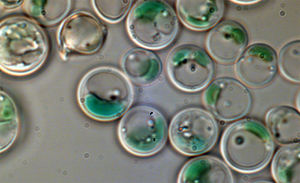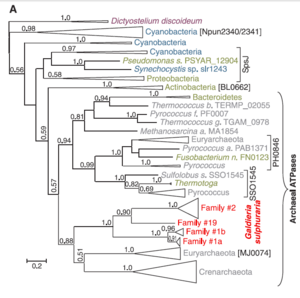Galdieria sulphuraria

Classification
Domain: Eukaryota; Class: Rhodophyta; Family: Cyanidiaceae; Genus: Galdieria
Species
Species: Galdiera sulphuraria
Description and Significance
Galdieria sulphuraria is a eukaryotic, spore-forming, coccus. G. sulphuraria appears yellow-green to dark blue-green grown heterotrophically in liquid culture, and often yellow or green in its natural environment. It is an acidophile, as well a thermophile, and inhabits highly acidic springs at high temperatures.
G. sulphuraria is a mixotrophic organism capable of both photosynthesis and the catabolism of a wide variety of metabolites.
Genome Structure
"At least 5% of protein-coding genes of G. sulphuraria were probably acquired horizontally." [1] Protein coding regions of the G. sulphuraria genome are highly condensed when compared with most eurkaryotic organisms; having a median average of two introns of length 55bp [6].
Cell Structure, Metabolism and Life Cycle
"presents a vacuole, a multilobed chloroplast and a net-like mitochondrion" [2]
"This alga shows an enormous metabolic flexibility, growing either photoautotrophically or heterotrophically on more than 50 carbon sources" [3]
Ecology

"The unicellular red micro-alga Galdieria sulphuraria (Cyanidiales) is a eukaryote that can represent up to 90% of the biomass in extreme habitats such as hot sulfur springs with pH values of 0 to 4 and temperatures of up to 56°C." [4]
"Some microbial eukaryotes, such as the extremophilic red alga Galdieria sulphuraria, live in hot, toxic metal-rich, acidic environments" [5]
References
[1] http://link.springer.com/content/pdf/10.1007%2Fs00253-007-1150-2.pdf
[2] http://link.springer.com/content/pdf/10.1023%2FA%3A1004035224715.pdf#page-1
[3] http://www.ncbi.nlm.nih.gov/pubmed/23471408
[4] http://genomics.msu.edu/galdieria/about.html
[5] http://www.ncbi.nlm.nih.gov/pubmed/23471408

